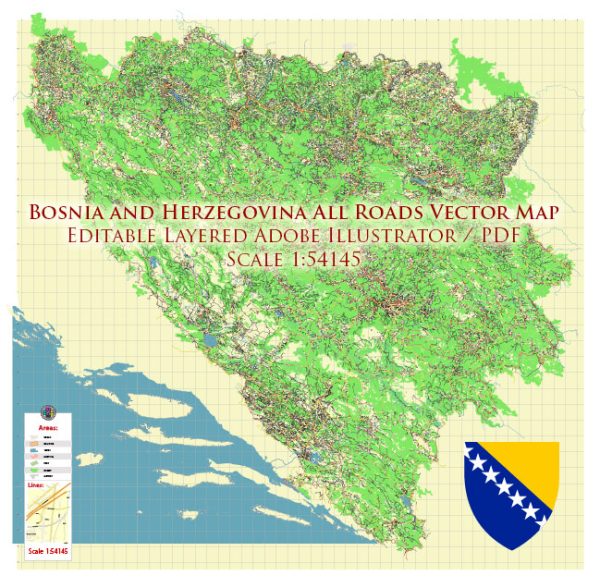Bosnia and Herzegovina, located in the Balkan region of Southeast Europe, has a rich history that has shaped its road system. The historical development of the road network in the region has been influenced by various political, economic, and social factors.
Vectormap.Net provide you with the most accurate and up-to-date vector maps in Adobe Illustrator, PDF and other formats, designed for editing and printing. Please read the vector map descriptions carefully.
Here is a brief overview of the history of the road system in Bosnia and Herzegovina:
- Ottoman Era (15th – 19th centuries): During the Ottoman Empire’s rule in the region from the 15th to the late 19th centuries, Bosnia and Herzegovina experienced some infrastructure development, including the construction of roads connecting major towns and administrative centers. These roads primarily served military and administrative purposes.
- Austro-Hungarian Rule (1878-1918): After the Congress of Berlin in 1878, Bosnia and Herzegovina came under Austro-Hungarian administration. The Austro-Hungarians invested in modernizing the infrastructure, including the road system. They constructed new roads and improved existing ones, connecting various parts of the region. This period marked the introduction of more systematic road planning and engineering.
- Kingdom of Yugoslavia (1918-1941): Following World War I, Bosnia and Herzegovina became part of the Kingdom of Serbs, Croats, and Slovenes (later renamed the Kingdom of Yugoslavia in 1929). During this time, efforts were made to further develop the road network, connecting the diverse regions within the kingdom. The construction of roads aimed to facilitate economic growth, trade, and communication.
- World War II and Socialist Yugoslavia (1941-1992): World War II brought significant disruptions to the region. After the war, Bosnia and Herzegovina became one of the six socialist republics within the Socialist Federal Republic of Yugoslavia. The socialist government continued to invest in infrastructure, including roads, as part of broader economic development plans. Roads played a crucial role in connecting rural and urban areas and promoting industrialization.
- Breakup of Yugoslavia and the Bosnian War (1992-1995): The breakup of Yugoslavia in the early 1990s led to the Bosnian War. Infrastructure, including roads, suffered extensive damage during the conflict. Many roads were destroyed or rendered impassable, hindering transportation and communication.
- Post-War Reconstruction (1995-present): After the Dayton Agreement in 1995, which ended the Bosnian War, efforts were made to rebuild and reconstruct the country. This included the rehabilitation of the road network. International assistance played a significant role in funding and executing reconstruction projects. The European Bank for Reconstruction and Development (EBRD) and other international organizations contributed to rebuilding key transportation routes.
- Current State: Today, Bosnia and Herzegovina has a network of roads that connect major cities and towns. The country is working on modernizing and expanding its road infrastructure to meet European standards. This includes efforts to improve road safety, increase capacity, and enhance connectivity both within the country and with neighboring regions.
It’s important to note that the road system’s history is intertwined with the broader historical and political context of the region, and developments in transportation infrastructure have played a crucial role in shaping the economic and social landscape of Bosnia and Herzegovina.


 Author: Kirill Shrayber, Ph.D.
Author: Kirill Shrayber, Ph.D.